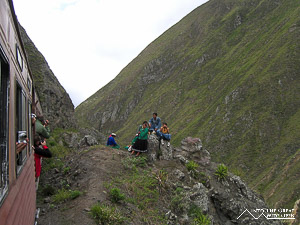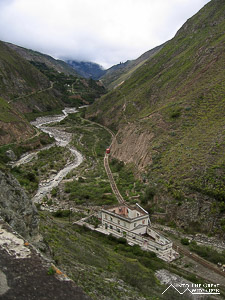Riobamba, Ecuador
Chimborazo and the Devil's Nose
January 23, 2008
I've seen the needle and the damage done
- Neil Young

Riobamba has the crumbling colonial character and air of a half-hearted revival that only a railroad town past its heyday can have. It is hard to ignore the visions of grandeur that the town must have conjured up during the prime of the railroad era when the city was in the middle of the railway line from the coastal city of Guayaquil to Quito. Sadly, the railway line doesn´t exist in its entirety anymore, only a small section from Riobamba to Sibambe is run several days a week solely for tourists. The other sections of the line were damaged in storms 10 years ago and have never been repaired.

Now, the train runs from Riobamba to Sibambe and then back to Alausi, since there are no hotels or transport services or apparently nothing much of anything left of Sibambe. The train runs on Wednesdays, Fridays, and Sundays and is almost always full due to the multitude of tourists clamoring to ride the train down the Devil´s Nose, supposedly a staggering engineering accomplishment. I arrived in Riobamba on Monday giving me one day to go see Chimborazo, the tallest peak in Ecuador at 6,300 meters, and I think also the highest active volcano in the world, and also time to buy a ticket for the train the day before it departed. Since I had already hiked up to the refuge at Volcana Cotopaxi I decided to something different for Chimborazo and went on a mountain biking tour that went around some of the towns near Chimborazo before passing in front of the volcano and back to Riobamba. It was especially convenient since the tour agency agreed to buy my train ticket for me.

It was an hour or so ride in a van continuously uphill to a dirt road in the middle of nowhere at an elevation of about 4,000 meters. From there we departed on bikes and it was essentially all downhill for about two hours with a few brief stretches of uphill riding on a fairly decent road. There were lots of rocks on the road and while there wasn´t any vehicular traffic you couldn´t come around the corners too fast because there were a lot of sheep and cows being herded along the roads. Everything was going fine until I blew out the rear tire on my bike going over a really rocky stretch, luckily I was able to maintain my balance and slow down to a gradual stop. I had to wait for the van to come along and switch to a spare bike for the remainder of the ride.
Unfortunately the extra bike was a bit smaller and not nearly as comfortable as the bike that I had originally picked out, but it was better than riding in the van. Once we reached the town in the valley the van drove us to the base of Chimborazo and we had lunch while the clouds cleared and gave us a great view of the peak and the glaciers on the mountain. There were even groups of vicuñas running around in the arid high desert, apparently they are some of the only animals that can survive in that harsh unforgiving environment. After lunch it was straight downhill on the bikes for another hour, with hardly any need to peddle, and then back to Riobamba in the late afternoon.

The next attraction was the train ride. The first negative about the train was that it leaves at 7am, and you are supposed to arrive 30 minutes early. That meant a very early wake up and an early breakfast since I wasn´t sure what opportunities there would be for food during the six hour train ride. The second negative was that you are no longer allowed to sit on the roof of the train. This was apparently one of the major advantages of the train ride, as it gave excellent views and made for a unique experience. Sadly, as rumor has it, two Japanese tourists ruined this for everyone (and for themselves) when they stood up, without paying attention, to take pictures and were both decapitated. Because of this accident, sitting on the roof is now prohibited for safety reasons. I found this rather ironic since the safety statistics of most other modes of transport are much more dangerous, and a mere two fatalities is negligible in terms of the numbers of people that ride the train. Considering that Bolivia proudly advertises trips down the world´s most dangerous road outside of La Paz, I think they should reconsider this policy.

Nonetheless, it made for much easier time boarding the train as everyone has an assigned seat and it was all quite orderly. The train ride itself was nothing special. It was slow, at one point a dog was outgaining us until it came to a ditch, bumpy, and the scenery was nice but not as spectacular as I was hoping for. For me, the interesting part was seeing all the abandoned buildings along the way that have no reason for existing now that the train doesn´t stop there anymore and there is almost no road access at all. The Devil´s Nose was interesting for the scenery, but as for the engineering accomplishment in building the tracks, I wasn´t that impressed. The train travels on what they call a V switchback, which simply means that it runs downhill to where the next track line intersects it and then it switches tracks and continues downhill in reverse.
This was certainly less than dramatic after all the build-up that I had read. At the bottom of the Devil´s Nose was the "town" of Sibambe. Not so much a town as an abandoned railway station, abandoned church and glimpses of a few other abandoned buildings on a hill. After stopping for 10 minutes for pictures we proceeded back to Alausi where there was a bus waiting to ferry all the tourists to Cuenca, the next stop on the tourist circuit, after the obligatory 45 minute wait to get people to spend money in Alausi.








































































